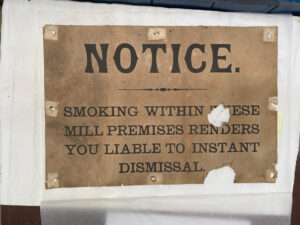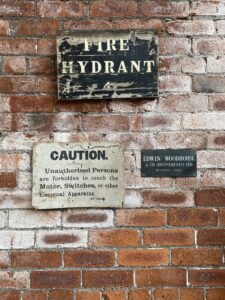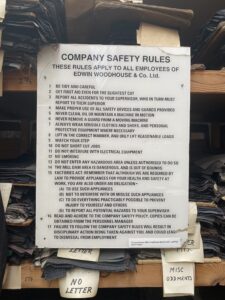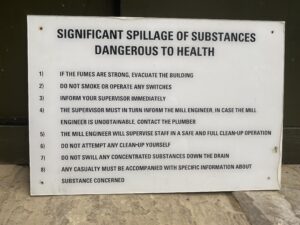The archive holds a collection of signs that were used as safety messages for staff throughout the mill. These range in material and typographic style, depending on when they were made.

This no smoking sign is one of the oldest, and most weathered signs in the collection. It features a decorative serif type. The rise of advertising is what stimulated the development of large scale and attention commanding typography. But it is still a far reach from the colourful simplistic signs we have today. This sign was likely produced in the 1880’s when decorative and larger fonts were implemented, which also aligns with Mr. Edwin Woodhouse’s take over. This period was studded with exciting new equipment and technology. Which may have been the catalyst for enforcing new safety instructions.

Above is a caution sign made from a thin wood, more durable than the previous paper sign, but has still slowly weathered. This more recent sign features a non-serif type face and uses both bold and enlarged fonts for emphasis. Making the message more accessible with just a quick glance. The inclusion of information on electrical apparatus and the sans serif font, indicates it could have been introduced in the 1950’s at an exciting moment for the mill for dyeing innovations. The new pressure systems allowed for smaller batches of dyeing.


The 1990’s safety signs are the most extensive, and most familiar to us with modern health and safety guidelines. These signs use a non-serif font like Futura, which was designed in 1927, but is still used today because of its clean and simple lines which makes it stand out and easy to read. The signs themselves feature a protective plastic layer, which although slightly damaged will keep the signs intact for many years to come.
The 1990’s not only introduced the extensive health and safety measures, but the hardships that would lead to closing the mill 18 years later, after a long struggle competing with the cheaper prices of Italy and china.
Blog post written by Kirstie Payne, Placement student from the University of Leeds
Back To Blog Next (Packing stamps) Prev (Sicklejay)
Tags
Arts & Culture General Museum & Archive
